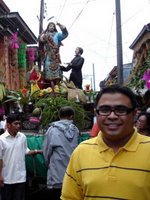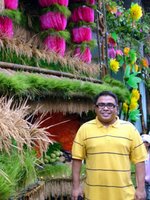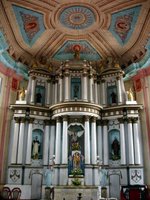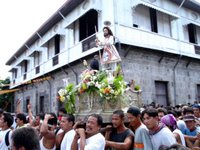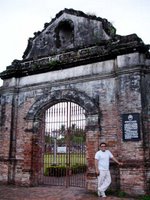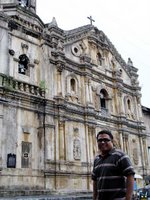 It was another adventure with Manila's streetwalker, my tokayo, Ivan ManDy. This time, it was in the most happening place in Manila before the war and the birthplace of our national beer... San Miguel!
It was another adventure with Manila's streetwalker, my tokayo, Ivan ManDy. This time, it was in the most happening place in Manila before the war and the birthplace of our national beer... San Miguel!Our walking tour actually started in Quiapo, in Asia's first all-steel church, the Basilica of San Sebastian. After looking around, I'm always fascinated by the Gothic architecture and stained-glass windows of this church, we were off to San Miguel. From San Sebastian, it was a short stroll towards Mendiola and its American period schools.
 The next stop was a little chapel in San Beda College known as the Abbey of Our Lady of Montserrat. According to the history of the Abbey, "In 1895 a group of Benedictine monks from the Abbey of Montserrat in Spain came to the Philippines and worked as missionaries and pastors in Surigao. Later they moved to Manila and in 1901 founded San Beda College. The community was raised to a priory in 1904 and in 1925 was elevated to the rank of Abbey with the titular of Our Lady of Montserrat."
The next stop was a little chapel in San Beda College known as the Abbey of Our Lady of Montserrat. According to the history of the Abbey, "In 1895 a group of Benedictine monks from the Abbey of Montserrat in Spain came to the Philippines and worked as missionaries and pastors in Surigao. Later they moved to Manila and in 1901 founded San Beda College. The community was raised to a priory in 1904 and in 1925 was elevated to the rank of Abbey with the titular of Our Lady of Montserrat." From there, it was through the Malacañang gates and security checks galore. Since we had a reservation at the La Cocina de Tita Moning (they had a letter with the guards complete with the names of all the guests), they let us in.
But this was a very sad picture of our country... barbed wire along the sidewalks ready for action when needed; a paranoid security detail always on hightened alert (even with the rallies going on in Bangkok, you could easily marvel at the architectural beauty of their government houses); the once see-through walls of the elegant old mansions in San Miguel now covered with metal sheets; I do hope the Malacañang complex becomes an area of the people again where Filipinos could walk around freely and enjoy their history and heritage. In fact, our bike escort (yes, we had a guard on a bike monitoring us while we were inside) did not even allow us to take a peek at Kalayaan Hall from the gates.
From Mendiola, we took a walk down Arlegui where more mansions could be seen. One of the mansions of interest is among the list of palace guesthouses. Known as the Arlegui Guesthouse it served as the official residence of two presidents namely Corazon Aquino and Fidel Ramos.
 According to the Malacañang website, the house is "a remodeled and enlarged 1930s mansion owned by the Laperal family. It later housed the Japanese Embassy, the National Library and the Presidential Economic Staff, one of the agencies that was later merged with another to constitute the present National Economic and Development Authority (NEDA). Mrs. Marcos doubled the size of the mansion when it was converted to a guesthouse; it now has two towers where it used to have one."
According to the Malacañang website, the house is "a remodeled and enlarged 1930s mansion owned by the Laperal family. It later housed the Japanese Embassy, the National Library and the Presidential Economic Staff, one of the agencies that was later merged with another to constitute the present National Economic and Development Authority (NEDA). Mrs. Marcos doubled the size of the mansion when it was converted to a guesthouse; it now has two towers where it used to have one." It was straight down the road on Arlegui and even more mansions. We then made a left on San Rafael where the Legarda House was located. The house had been converted into a fine dining restaurant called La Cocina de Tita Moning, giving their clients a glimpse into the family recipes and lifestyle of the Legarda household. There are set meals available for a minimum of two and a maximum of 50 people. But for us, it was just a sampler. For our welcome drink, we had lemon grass tea. And for our meal, it was pasta with the special chopped tomato sauce, baked chicken with garlic and banana cue for dessert, which was accompanied with vermouth as its "syrup." The houses also had a shop where one could purchase bottled family specialties such as the queso de bola spread, vinigarettes, and sauces.
It was straight down the road on Arlegui and even more mansions. We then made a left on San Rafael where the Legarda House was located. The house had been converted into a fine dining restaurant called La Cocina de Tita Moning, giving their clients a glimpse into the family recipes and lifestyle of the Legarda household. There are set meals available for a minimum of two and a maximum of 50 people. But for us, it was just a sampler. For our welcome drink, we had lemon grass tea. And for our meal, it was pasta with the special chopped tomato sauce, baked chicken with garlic and banana cue for dessert, which was accompanied with vermouth as its "syrup." The houses also had a shop where one could purchase bottled family specialties such as the queso de bola spread, vinigarettes, and sauces. After second and even third servings and some chatting here and there, we continued our walk. Right beside the Legarda House is another well preserved art deco mansion which today is the Malacanang Clinic. This used to be the home of former chief of staff of the Philippine Army, Dr. Basilio Valdes.
After second and even third servings and some chatting here and there, we continued our walk. Right beside the Legarda House is another well preserved art deco mansion which today is the Malacanang Clinic. This used to be the home of former chief of staff of the Philippine Army, Dr. Basilio Valdes.From San Rafael, we took a right back on J. P. Laurel and exited the secured area of the palace complex towards the San Miguel Church. But we made a brief stop in front of an empty part of the palace lawn where the offices and factory of the tenth largest brewery in the world was first built over a century ago. The San Miguel Brewery factory is no longer there. That alone would have been a museum worth visiting if it were still standing today. Sigh!
 The San Miguel Church has a lot of history attached to it. It was for several years in our history the seat of the Archdiocese of Manila when the Manila Cathedral lay in ruins after the war. The church was host to celebrity weddings as well including that of President Ferdinand Marcos to then Imelda Romualdez.
The San Miguel Church has a lot of history attached to it. It was for several years in our history the seat of the Archdiocese of Manila when the Manila Cathedral lay in ruins after the war. The church was host to celebrity weddings as well including that of President Ferdinand Marcos to then Imelda Romualdez. We were nearing the end of our tour. Our last stops were two more Malacañang guesthouses. "The Goldenberg Mansion (so called after the previous owners) was informally referred to by Mrs. Marcos as the 'big antique.' A historic structure built by the Eugster family (probably Spaniards long returned to Spain) about a hundred years ago, it was the office of the Marcos Foundation, a cultural heritage structure. It was a combination residence and shampoo factory when bought by the Marcoses and exquisitely restored by Architect Leandro Locsin in 1971.
We were nearing the end of our tour. Our last stops were two more Malacañang guesthouses. "The Goldenberg Mansion (so called after the previous owners) was informally referred to by Mrs. Marcos as the 'big antique.' A historic structure built by the Eugster family (probably Spaniards long returned to Spain) about a hundred years ago, it was the office of the Marcos Foundation, a cultural heritage structure. It was a combination residence and shampoo factory when bought by the Marcoses and exquisitely restored by Architect Leandro Locsin in 1971. "It held Mrs. Marcos' collection of excavated porcelain and pottery, Ban Chieng prehistoric pottery from Thailand and Filipiniana book rarities, and treasures such as a statue from Angkor and Chinese jade furniture.
"The Teus house next door was purchased and converted to a guesthouse in 1974, under the supervision of decorator Ronnie Laing. It has a large living-dining area that held a display of antique European silverware (since sold at auction), including some by famous 18th and 19th century silversmiths Paul de Lamerie and Paul Storr. Much of these were apparently given to the Marcoses on their silver wedding anniversary."
Talk about opulence in the Philippines! Despite their many faults, the Marcoses, particularly Imelda and her edifice complex, made Manila the most happening place in all of Asia. The results of these whims and caprices are architectural legacies such as the Cultural Center of the Philippines among many others.
 In front of the two mansions was a shop which should be of particular interest to those who would like a piece of Philippine heritage in their homes. The old tiles we see in old houses and churches are made by companies such as the Machuca Tile Company which has made tiles since 1900. Their office is in front of these mansions and if you check the photo, their phone number is in the sign.
In front of the two mansions was a shop which should be of particular interest to those who would like a piece of Philippine heritage in their homes. The old tiles we see in old houses and churches are made by companies such as the Machuca Tile Company which has made tiles since 1900. Their office is in front of these mansions and if you check the photo, their phone number is in the sign.That was the end of the tour and it was back to San Sebastian by jeep. That's it for now.

